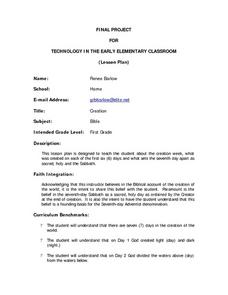Curated OER
Moons
Students practice rote counting to 20. After a lecture about the planets and the moons that surround them, they identify the number of moons surrounding various planets. Students compare and contrast the quantity of moons surrounding...
Curated OER
A DISAPPEARING ACT Astronomy: Do Stars Always Shine?
Students observe why stars are not visible during the day with a classroom demonstration using an index card punched with holes.
Curated OER
The Penguin Legend
Students look at the pictures of penguins on the Penguin page and select one they would like to write a legend about.
Curated OER
Once In a Blue Moon
Young scholars review the characteristics of the planets and their moons. Using the internet, they research the relationship between the Earth and its moons. They take a template of the moon and draw craters of different colors to...
Curated OER
Technology In The Early Elementary Classroom
First graders explore the creation of the world and what was created on each specific day. They read the creation of the world from the Bible, watch a video, and sing a song about the Creator. Using Kid Pix software, 1st graders create...
Curated OER
Is It Lunar or Lunacy?
Sixth graders are introduced to the moon and its phases. Individually, they draw a sketch of each phase of the moon and read a short article about Galileo. To end the lesson, they examine the difference between refracting and...
Curated OER
Modeling Celestial Motion
For this modeling celestial motion worksheet, students fill in the blank about the motion of celestial bodies: planets and stars. Students complete the blanks with information about the scientists and philosophers responsible for early...
Curated OER
Answering Science Questions
Young scholars examine the ways in which scientists answer questions. In this critical thinking and scientific process instructional activity students complete a worksheet of questions.









